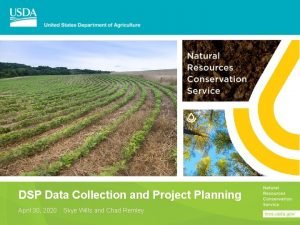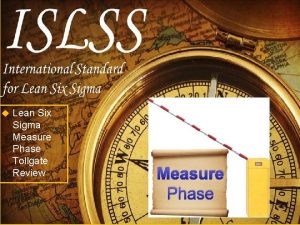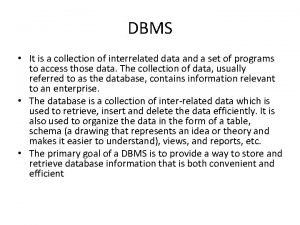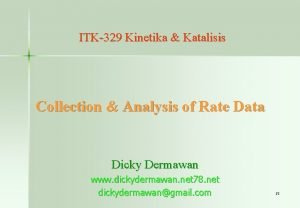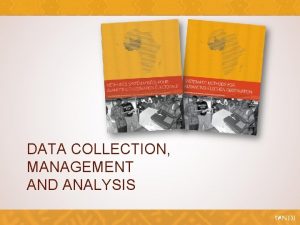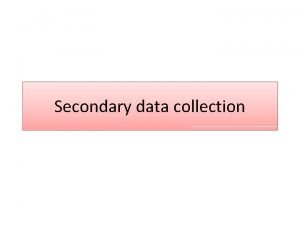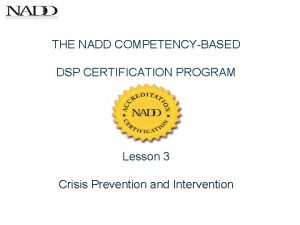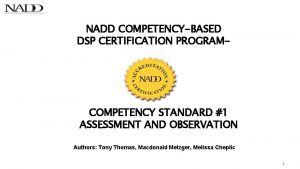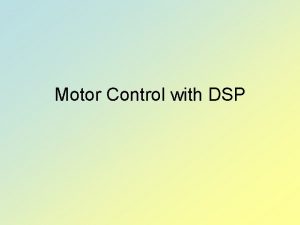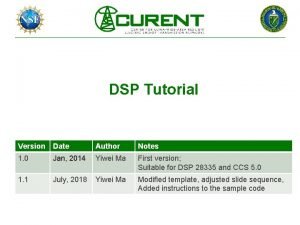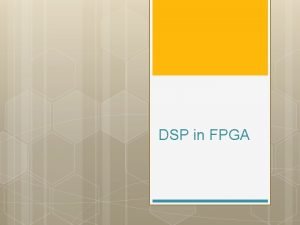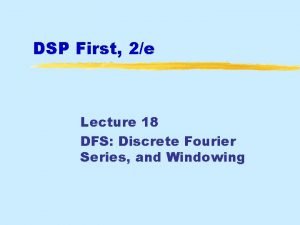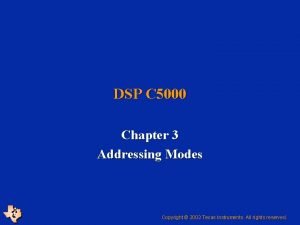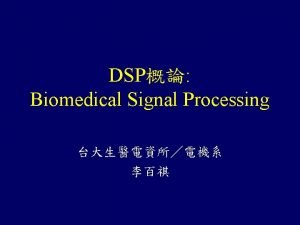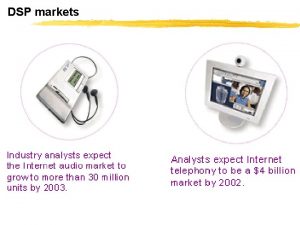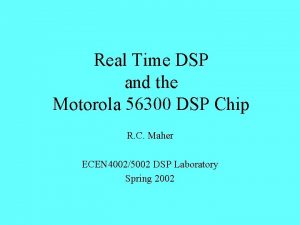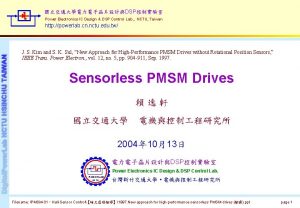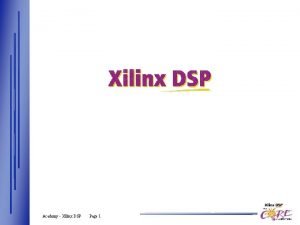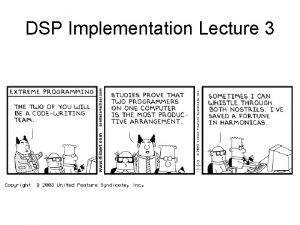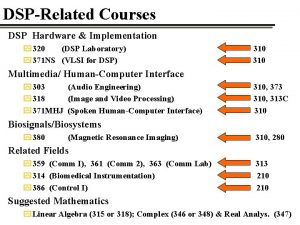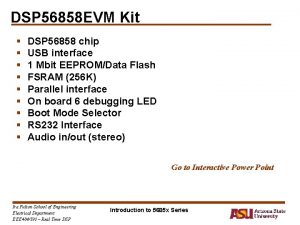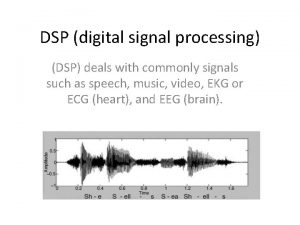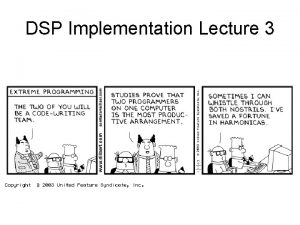DSP Data Collection and Project Planning April 30






































- Slides: 38

DSP Data Collection and Project Planning April 30, 2020 Skye Wills and Chad Remley

Dynamic Soil Properties A look Backwards and Forwards National Instruction Guidance documents

Dynamic Soil Properties Millennia DSPs are properties that change with land use and Centuries management Soil Survey can document properties that change on the Decades human time scale – decades to Richter and Markowitz, 2001 centuries. Use-dependent properties Soil Change Guide

Why Dynamic Soil Properties? Knowledge of DSPs is needed to address emerging issues: To Assess soil condition Compare measured/observed values to expected potentials for similar or alternative management systems To Improve Conservation Adjust conservation plans and practices to account for previous soil change Calibrate and validate models used in conservation planning To predict and scale soil change Aggregate observations and link to layers with relevant soil and management information Knowledge of alternative states/systems can be used to predict change under different conditions

The rancher’s sample is represented by the star, with 25% aggregate stability. The interpretation of that value depends on the kind of soil. In a sandy Amarillo soil, 25% is very good for any land use. In a Kirkland soil, 25% is good for a tilled soil, but is far below a typical rangeland. The rancher on a Kirkland soil should evaluate their management plan and consider applying conservation methods to avoid rangeland degradation and a loss of forage production.

Next Steps for DSPs

Corollate and Collaborate with Soil Health Joint projects with Soil Health Division and State efforts to evaluate soil health • Combine DSP data collection with soil health field assessments

Science of Soil Health Initiative #DSPs 4 SH Cooperator Agreements across a range of soil and management systems • Soil Health Tech Note • https: //directives. sc. egov. usda. gov/Open. Non. Web. Content. aspx? conte nt=44475. wba • Soil Health Field Assessments • • National Local • DSP methods • Soil Characterization

Science of Soil Health Initiative #DSPs 4 SH Outcomes 1. List of relevant DSPs and reference values that can be used to assess soil health status by soils under different management systems 2. Data (measurements) and information (interpretations) for a standard set of DSPs on one or more benchmark soils and soil landscapes to be included in national soil and ecological site databases maintained by NRCS 3. Recommendations for conservation planning and conservation effects assessment

DSP Information • Need to aggregate DSP information across projects • Need to extrapolate DSP information to unmeasured soil and conditions • Need to provide information to users through multiple platforms

DSPs in Agro-ecossystems We know that ecological site concepts can be used to stratify the landscape into meaningful units in order to make management decisions. There is current work to expand these concepts to intensively managed agricultural systems.

Ecological Sites and State and Transition Models in Agro-ecosystems We know that ecological site concepts can be used to stratify the landscape into meaningful units in order to make management decisions. 1. Number and extent of rills: There are few, There is current work to expand these concepts to if any, rills and there is no active intensively managed agricultural systems. headcutting and sides are covered with vegetation. 2. Presence of water flow patterns: There is some evidence of soil deposition or erosion, particularly after significant rain events, but water generally flows evenly over the entire landscape … 15. Expected annual production (this is TOTAL above-ground production, not just forage production): Normal production is 2838 -4964 pounds per acre.

Soil Functions / Ecosystem Services Native / Naturalized Plant Communities High Low Native/ Naturalized States Ecological Potential

Low Native/ Naturalized States Agricultural Production Groups Vegetable Rotation Root Crops Forage Crops Grain Rotation Native / Naturalized Plant Communities Soil Functions / Ecosystem Services High Ecological Potential Attainable for Grain Rotations Production Group

Grain Rotations Soil Functions / Ecosystem Services Ecological Potential Continuous no-till w/ cover crops Attainable for Grain Rotations Production Group Organic system w/ cover crops Rotation, low-till, no cover crops Diverse rotation, tillage Monocrop, Deep tillage Disturbance within one Agricultural Production Group

Science of Soil Health Initiative Soil Functions / Ecosystem Services Preliminary Results – PLFA at SHAC

Soil Functions / Ecosystem Services Preliminary Results – PLFA at SHAC Ecological Potential Attainable for Grain Rotations Production Group

Other uses of DSP information Assessing ‘typical’ or likely values for soil health metrics. Curves based on temperature, rainfall, texture and groups of soil taxa. Preliminary Work of Marcio Nunes and Kristen Veum

DSP projects Ongoing across the country Apps being developed to share information

National Instruction and National Bulletin

DSP Data Collection Kind Intensity Why is the data being collected? What will it be used for? How detailed is the data collected? • • • Dispersed Project Extensive Intermediate Intensive

National Instruction Defines Tiers of DSP Data Collection for all of Soil Survey • Initial Soil Survey • Extensive data collection • Update Soil Survey • • Intermediate data collection – 1 project per year Extensive data collection – any time characterization sampling is done

DSP collection: Dispersed vs. Projects • Dispersed: • • Additional information collected while completing other soil survey activities. Full descriptions of structure, pores and earth cover kind help us have a complete database ‘Extra’ information collected to fully represent the range of conditions and properties present for a given soil, component or map unit • Project • • • Target Soil or Catena Target conditions: land use, ecological states or management systems Replication across range of soil and conditions

Data collection Frequency Type DSP and related properties Water-stable aggregates; Permanganate oxidizable carbon (POXC or Active C); Beta-glucosidase and other enzymes Source and data storage Review sample handling and processing guidance with KSSL. Particulate organic matter; Intensive Tier: Used for DSP projects and laboratory sampling. Kellogg Soil Survey Effective cation exchange capacity; Laboratory Plant available P (appropriate method based on region/soil); measurements Continue measuring as p. H (H 2 O and Ca. Cl 2); Total carbon, organic carbon + inorganic carbon; Total nitrogen; Particle size; Exchangeable cations Other laboratory measurements Sample: Phospholipid fatty acids (PLFA); Sample: Ester-linked fatty acid methyl ester profile (EL-FAME); Microbial biomass; DNA profiling / metagenomics Respiration appropriate using current protocols. Optional: Collaborate or contract with other labs. Explore development for future laboratory expansion. There is additional sampling collection guidance in the KSSL submission guidance for intensive tier projects: DSP Sampling and ID Guide_KSSL. docx

Data collection Frequency Type Field observations Intermediate Tier: Used for dispersed data collection and appropriate Field measurements projects. Also required for the intensive tier for KSSL sampling, DSP projects, and characterization. Soil survey field office laboratory measurements DSP and related properties Source and data storage Ecological site ID and community; General land use and management information See Ecological Site Handbook. DSP Management Questionnaire. Vegetation measurements as appropriate (see table 9 -1) Encourage collaboration with ecological science specialists in SPSD and other offices. Soil moisture; Soil temperature; Bulk density; NASIS field and appropriate documents Infiltration Ksat; Soil health field assessment Use locally appropriate assessments with input from State personnel and Soil Health Division personnel. Earthworms Soil quality kit guide Water stable aggregates; See Field Lab Methods and Permanganate oxidizable carbon appropriate NASIS fields. (POXC or Active C) Respiration Under development.

Data collection Frequency Type DSP and related properties Source and data storage Populate existing fields Extensive Tier: Earth cover kind; in NASIS. See NSSH Always recorded as Soil crusts and cracks; Field observations 622. 13 and Field Book part of any soil Soil structure; for Describing Soils 2 survey observations. Roots and pores 70 through 2 -79.

For All KSSL Characterization Projects Follow DSP guidelines: Sample • 0 – 5 cm, 5 – 10 cm, 10 cm to bottom of the next horizon, by genetic horizon • Two satellite pedons to 0 – 5 cm, 5 – 10 cm, 10 cm to bottom of the next horizon, by genetic horizon to 50 cm Measure • Intermediate level field values Submit • Follow latest KSSL guidelines • Avoid crushing samples, overly wet samples, leaving samples in extreme conditions etc. • Submit completed 232 in NASIS, DSP Management Questionnaire, and DSP Workplan Worksheet • Include x, y locations for all individual satellite pedons Any Deviations Should be approved by your KSSL liaison following guidance from National Leader for Soil Research.

National Bulletin Outlines expectations for the coming fiscal year Provides Guidance documents: these documents layout what is expected for DSP data collection and projects There will be challenges as these guidelines are used in new regions, soils and conditions. Provide feedback, work with your liaisons to troubleshoot.

DSP Guidance Documents “Soil Survey Manual, ” Chapter 9, for a more complete explanation of DSPs: https: //www. nrcs. usda. gov/wps/portal/nrcs/detailfull/soils/ref/? cid=nrcs 142 p 2_054262 DSP data element documentation (excel spreadsheet of data tiers): https: //new. cloudvault. usda. gov/index. php/s/k 3 LLTab. Ni. Wtcysj NASIS data elements (existing fields and choice lists): https: //new. cloudvault. usda. gov/index. php/s/EWs. Jd 5 ea. XS 6 Wa. SZ Soil Management Questionnaire for Intermediate and Intensive DSP Data Management: https: //new. cloudvault. usda. gov/index. php/s/JC 4 rng. MDtx. Ao. Kk. P KSSL submission guidance for intensive tier projects: https: //new. cloudvault. usda. gov/index. php/s/rwo. DHc. Qw 9 fsgcxm Workplan worksheet for assistance planning an intermediate or intensive DSP project: https: //new. cloudvault. usda. gov/index. php/s/R 2 Rtc. KBsbn 7 ff. Hr Frequently Asked Questions (will be updated): https: //new. cloudvault. usda. gov/index. php/s/z. XYP 4 x. Cat 2 y 7 q. Zg

DSP Data Collection initial Extensive Dispersed Intermediate KSS L Intensive Project Intermediate Intensive

Interim data storage Cloudvault locations (contact your NSSC/KSSL liaison) https: //new. cloudvault. usda. gov/index. php/s/2 Tpt. Tg. Ts 5 ETfwf 9 • Collect workplan worksheets for projects • Collect Management Questionnaires • Word document or • Survey 1 -2 -3 https: //arcg. is/1 TWqy. P These will eventually be deployed through NASIS and ‘regular’ channels. We’d like to keep track and gather feedback through the initial adoption of the National Instruction.

Project Planning

Intermediate and Intensive Projects DSP Workplan Worksheet • guides you through the planning process • • Consider all parts of the worksheet, make notes This serves as project plan • prepopulated with an example project

DSP Workplan worksheet Background Information • Project Tier • • level of data collection Project Title • • Guidance Given in DSP Sampling and ID Guide KSSL_2020 This will help track the project in KSSL Project–Include the following elements separated by a space: – – Project Type: Always “DSP” for DSP projects. State and MLRA: Two-digit State code or MLRA abbreviation. Year: The calendar year the project was started. Use 4 digits. Soil series or ecotype: Use one or two words. Describe the major soil series or ecotype system being evaluated. The IDs should be identical: Workplan worksheet_DSP_2020. docx KSSL and NASIS: DSP Sampling and ID Guide_KSSL. docx

Summary

DSP Data Collection and Project Planning • Future uses of DSPs will support agency and SPSD goals • National Instruction and Bulletin outline DSP data element and expectations for collection • Attachments provide DSP Guidance • Three Tiers of Data collection • • • Extensive – basic information collected widely Intermediate Intensive – detailed information collected on a limited spatial extent • Two types of data collection • • Dispersed – general DSP data/information added to activities Projects – focused on specific soils and issues • Workplan worksheet • Guide the project planning process

Guidelines and Workbooks

Questions Skye Wills Chad Remley Get Involved, shape future guidance – Join the DSP Focus Team
 Dsp data and system planning
Dsp data and system planning Tollgate review
Tollgate review Sample prayer for meeting
Sample prayer for meeting Data collection procedure
Data collection procedure Landsat collection 1 vs collection 2
Landsat collection 1 vs collection 2 Documentary collection
Documentary collection Data collection secondary data sources
Data collection secondary data sources April art project
April art project Dsp for embedded and real time systems
Dsp for embedded and real time systems Dsp algorithms and architecture
Dsp algorithms and architecture Collection organization and presentation of data
Collection organization and presentation of data Interrelated data examples
Interrelated data examples Collection and analysis of rate data
Collection and analysis of rate data Gis data input
Gis data input Data collection management and analysis
Data collection management and analysis Raw facts and figures
Raw facts and figures What is secondary data
What is secondary data Data analysis in research sample
Data analysis in research sample Inactivism planning
Inactivism planning Short term planning and long term planning
Short term planning and long term planning Language policy in pakistan slideshare
Language policy in pakistan slideshare High precision dsp
High precision dsp Nadd dsp certification
Nadd dsp certification Dsp tms
Dsp tms Dbhds values direct support professionals who
Dbhds values direct support professionals who Nadd dsp certification
Nadd dsp certification Dsp motor control
Dsp motor control Dsp vs microprocessor
Dsp vs microprocessor Frequency warping in dsp
Frequency warping in dsp Introduction to dsp
Introduction to dsp Ess dsp
Ess dsp Dsp algorithms tutorial
Dsp algorithms tutorial Dsp service provider
Dsp service provider Fpga vs dsp
Fpga vs dsp Difference between dfs and dft
Difference between dfs and dft Circular addressing mode in dsp
Circular addressing mode in dsp Application of dsp in biomedical
Application of dsp in biomedical Dsp processor fundamentals
Dsp processor fundamentals Dsp computational building blocks
Dsp computational building blocks
